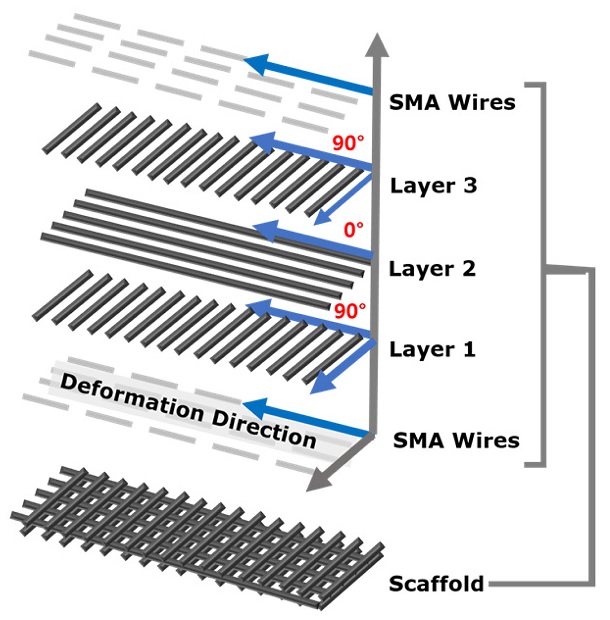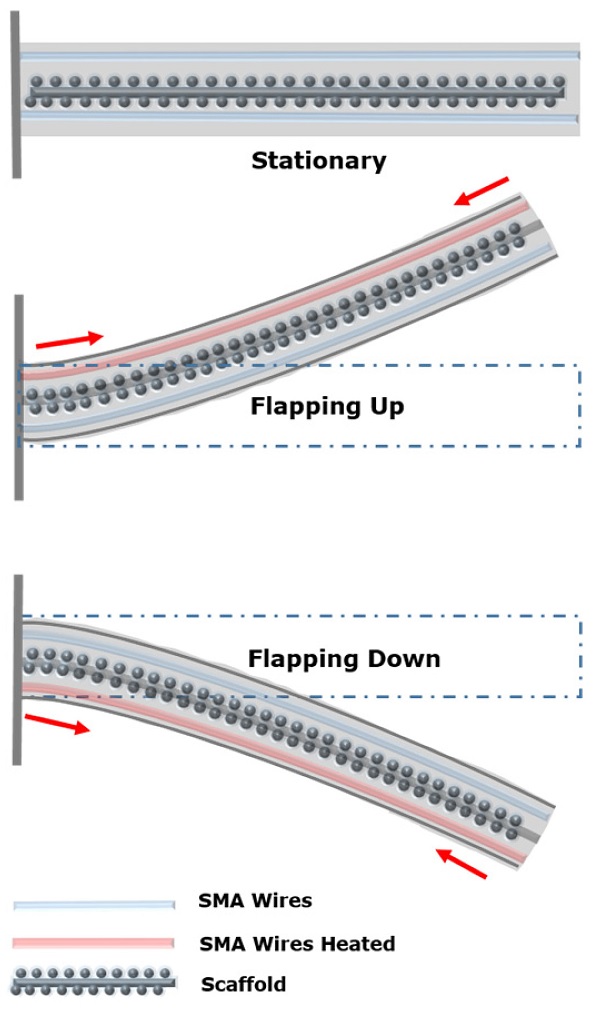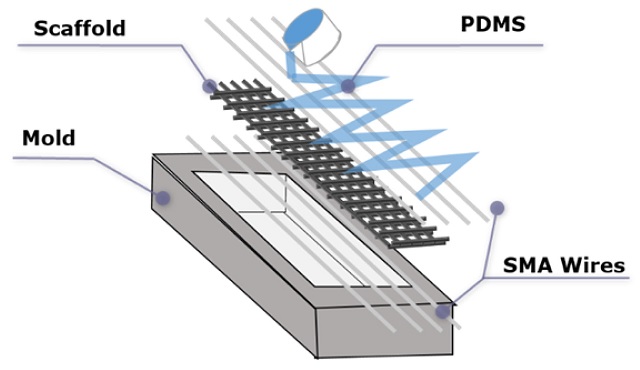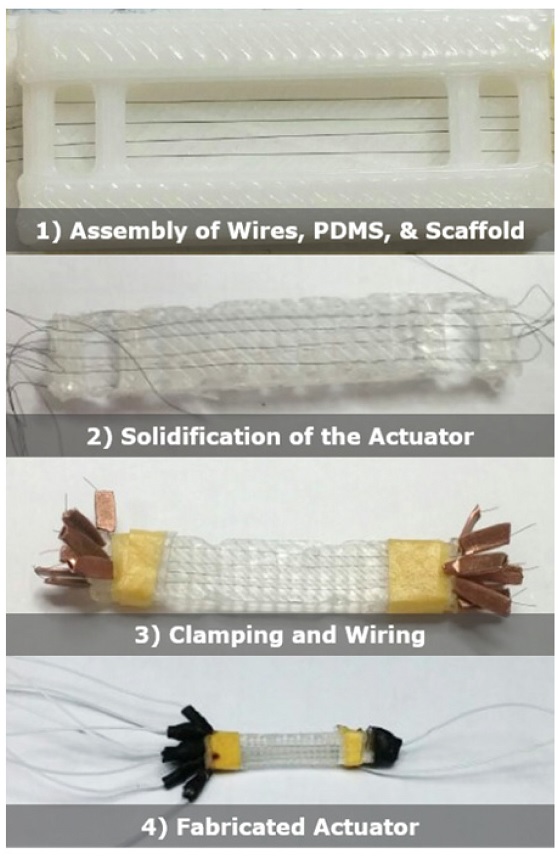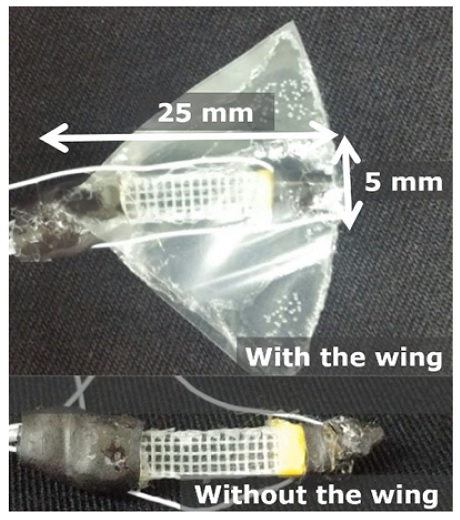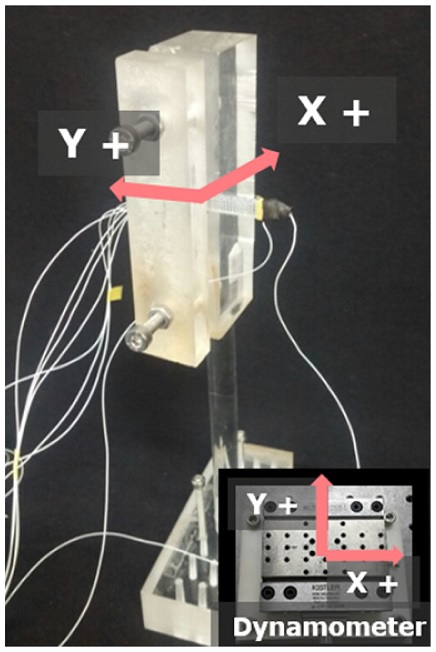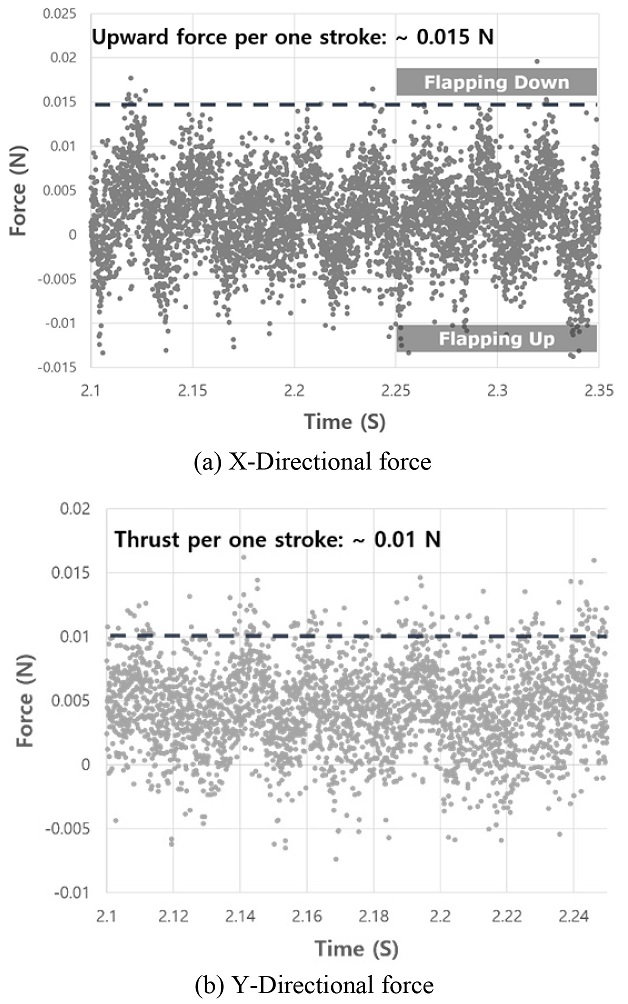
Fabrication of Miniature High-Speed Actuator Capable of Biomimetic Flapping Motions
Copyright © The Korean Society for Precision Engineering
This is an Open-Access article distributed under the terms of the Creative Commons Attribution Non-Commercial License (http://creativecommons.org/licenses/by-nc/3.0) which permits unrestricted non-commercial use, distribution, and reproduction in any medium, provided the original work is properly cited.
Abstract
Beyond conventional military products, technologies in the defense industry sectors around the globe are integrated and fused with newly emerging technologies such as three-dimensional printing (3DP) and smart material fabrication. Acknowledging these trends, this study proposes a miniature high-speed actuator whose fabrication process entails 3DP, smart materials, and shape memory alloy. The manufactured actuator is 25 mm long and 5 mm wide in and weighs 2.5 g, having the optimal frequency in the range of 35-40 Hz. Force and deformation measurement were also conducted, resulting in the lift force of 0.18 N per second with a bending deformation of 5 mm.
Keywords:
Flapping actuator, Shape memory alloy, Smart soft composite, Biomimicry, Natural frequency키워드:
날갯짓 구동기, 형상 기억 합금, 지능형 연성복합재료, 생체 모방, 고유 진동수1. Introduction
Recently, emerging technologies are being integrated into the defense industry in each country. In the past, its trend was to make more destructive and powerful weapons to overpower other nations. Yet, the defense industry, as its name implies, entails a few distinguishing sectors of technologies used for the defense mechanism of its sovereignty. In the presence of relatively new technologies such as IT (information technology), machine learning, and three-dimensional printing (3DP), there exists necessity and the demand for a new type of machinery and equipment for the defense industry. The United States is researching technology to mobilize swarms of smaller and simpler robots to sneak around an enemy's defenses, with communication capability.1 It was well demonstrated these small drones in cooperation and in the network of swarm intelligence are capable of building, detecting and even mapping the geographical information in the vicinity.2,3 Also, the 3DP technology has made it possible to reduce the time and manufacturing process needed in fabricating military products. Owing to the faster process of making the prototypes, the modification of new weapons and products has become accelerated as well.4 As described above, a few keywords of the cutting edge technologies which also coincide with the themes of the defense development are ‘3DP’ and ‘miniature flying robots’. In this context, the objective of the paper is to develop a small high-speed flapping actuator using 3DP technology.
In terms of making a small-sized robot, many scholars have made the usage of smart materials to fabricate moving actuators, due to its light weight, multi-functionality, and diverse activation mechanism for making movements. A few of the most well-known smart materials include ‘ionic polymer metal composite (IPMC)', ‘lead zirconate titanate (PZT)’, and ‘shape memory alloy (SMA)’. Nowadays, by using these smart materials, miniaturization of actuators which could be implemented in machinery, robots, and/or weapons is possible without using motors, nuts, gears, and mechanical link structures. Additionally, biomimetic robots could be manufactured, based on the actuators comprised of the smart materials. To relate to some previous cases, ‘IPMC’ actuators are widely applied into making underwater robots in biomimicry of a jellyfish and fish.5 For the case of robots using ‘PZT’, Wyss Institute made small sized ‘RoboBees’ with the purpose of achieving artificial pollination and detection of hazardous substance nearby.6 Particularly, SMA based actuators have not been applied to making a robotic bird or insect yet, but there have been a few examples of creating biomimetic robots in the physical imitation of a turtle, earthworm and a flea.7-10 As this study revolves around building a miniature high-speed actuator with SMA wires, it is necessary to look at the incremental developments of SMA actuators. That is, first the fabrication of these SMA based robots and applications was made possible due to the development of ‘Smart Soft Composite (SSC)' which enables the multidirectional movements of the actuator in a combination of the scaffold patterns inside.11 Shortly after, the performances of the SSC were upgraded with the movement frequency of 35 Hz.12 However, in order to utilize this high-speed actuator to make a robotic bird or insect, the dimension of its size and the flapping speed need enhancements. In this sense, the proposed research ventures a new type of high-speed SSC actuator that is smaller and faster, which may be used to develop a roving robot for the future defense industry. Future applications of the miniature actuator may include a small-sized biomimetic drone.
2. Miniature Flapping Actuator
2.1 Materials and Actuation Mechanism
The core functionality of the miniature actuator is to make flapping motions. Though the flapping motions may seem simple, this is realized in combinations of three major components within the actuator, which are PDMS (polydimethylsiloxane), sets of SMA wires, and a scaffold. First, the scaffold controls the behavior of the flapping movements of the actuator and supplies stiffness to the mass. The scaffold is composed of three different layers and the trajectory of the actuator is largely affected by the configuration of each layer at the interface of the two layers of SMA wires up and down, as shown in Fig. 1. Next, the source of power for such motions is the alternative cycle of SMA wires’ shrinkage and elongation caused by the heat from the current conducted on the wires. The specification of the SMA wires used in the actuator is described in Table 1. It should be noted that the diameter of the SMA wires used in the miniature high-speed actuator is 38 μm, approximately one-third of ordinary hair.
As the driving force of the actuation is the deformation caused by the cyclic heating and cooling of the SMA wires, the heat dissipation is a significant factor for the flapping response of the actuator. The higher the rate of heat dissipation is, the faster the flapping frequency becomes available. Lastly, PDMS holds the scaffold and SMA wires all together in the form of a soft elastic piece.
Now, in more details of the actuation mechanism, the heated side of the SMA wires get contracted and it results in bending deformation, illustrated in Fig. 2. Within the actuator, two groups of SMA wires are located up and down from the scaffold, each with 4 SMA wires. When one set of the wires are heated with electricity, the other set of SMA wires goes through natural cooling. During the cooling cycle, the tension rendered by the scaffold and the other set of the SMA wires relocates the mini actuator to its original position. This process is repeated in the presence of the cyclic heating of the SMA wires.
2.2 Fabrication
To manufacture the miniature high-speed actuator, the aforementioned scaffold and the mold which would render a physical shape to the liquid PDMS are first 3D printed. The material used for the printing is ‘ABS’ (Acrylonitrile Butadiene Styrene). After this 3DP process, SMA wires are positioned above and below the surface of first and bottom layers of the scaffold, respectively all inside the mold, as depicted in Fig. 3. Then, PDMS is cast into the mold and solidified in hot and dry air conditions for a few hours.
Upon the completion of the curing process of the miniature actuator, SMA wires are clamped with a metal pipe. The clamping task is carefully carried out in ways the SMA wires make no contacts with each other. This process serves another important role in holding the SMA wires with fixed length along the actuator. Without this step, the actuator will not display any flapping movements. After the clamping task, the SMA wires are soldered with thin electric wires and then coated with rubber. This finalizes the manufacturing process of the miniature actuator.
3. Experiment & Result
To measure the force by the flapping motions of the small type actuator, the experiment was designed to be conducted two times with and without the wing attached to it. The material of the wing used is polyvinyl and was attached to the top and bottom surface of the actuator, as shown in Fig. 5. The total mass of the actuator is 2.5 g and its length and width are 25 and 5 mm, respectively. The span of the wing is about 30 mm.
The setup for the force measurement is shown in Fig. 6. The symbols indicated as X and Y specify the directions of the force gauged. The X-directional force refers to the lift force as it coincides with the direction of its bending deformation. The Y-directional force, on the other hand, is not directly related to the lift force, but instead, it is the measurement value for the thrust created toward the stationary end of the actuator.
The mini flapping actuator was installed with the gripper on the dynamometer for the force measurements. As planned from the beginning, the measurements were conducted with and without the presence of the wing structure. However, the moving speed of the actuator was largely changed owing to the different stiffness induced by the wing structure; its natural frequency was lowered to about 10 Hz. For this reason, the force measurement was mainly conducted only for the miniature actuator without the wing attached.
For the actuation, each set of the SMA wires above and below the scaffold was alternatively heated by the conditions of 7.6 V and 0.56 A at 36 Hz. The result of the force generated by the miniature actuator is visualized in Fig. 7. As the actuator was tested with the frequency of 36 Hz, there exists the indication of 9 strokes within the time frame of 0.25 second, labeled by the X axis. The trend of the plots fluctuates as the flapping motions occurred. The maximum upward force created by the down stroke of the actuator is about 0.015 N. However, it is important to keep in mind that, the calculation of true lift force should account for the presence of the downward force induced by the flapping up strokes. The difference between the upward and downward force is the lift force which plays a role in making the body fly. The lift force per one stroke is about 0.005 N. The number itself may seem small. However, the lift force per one second is 0.18 N, calculated from the multiplication between the lift force per stroke and the frequency of the flapping movements. Considering that the weight of the actuator is about 2.5 g, the value of 0.18 N is meaningful; it is 7.3 times bigger than its weight of 0.0245 N.
The Y-directional force was evaluated as a measure of a thrust toward the stationary end of the actuator. The value recorded is about 0.01 N. This value is not so much associated with the actuator’s capability of flying but could be meaningful in other applications such as a fin of fish.
Lastly, the bending deformation induced by the alternative heating of the SMA wires was about 5 mm, as referenced in Fig. 8. This value was obtained as a result of exciting the actuator at its natural frequency which seemingly lied between the range of 35-40 Hz. The experiment results are summarized in Table 2.
4. Conclusion
As the trend of the defense industry is being affected by the new emerging technologies, different approaches to making military products are adopted as well. This paper showed the process of fabricating a small type high-speed actuators in the glimpse of developing a robotic bird in the future. The fabricated small type high-speed actuator was able to go beyond the former highest record of 35 Hz frequency. The contribution of the research is in the increase of the flapping frequency between 35-40 Hz and its small size which is 25 mm long and 5 mm wide. Not from a distant future, it will be technologically possible to make a small-sized biomimetic drone, using the developed miniature actuator fom this research.
Acknowledgments
This work was supported by a grant to Bio-Mimetic Robot Research Centre funded by Agency for Defense Development (UD130070ID) and by the Industrial Strategic technology development program(10049258) funded by the Ministry of Knowledge Economy (MKE, Korea).
REFERENCES
- Financial Times, https://www.ft.com/content/849666f6-cbf2-11e5-a8ef-ea66e967dd44?mhq5j=e2, (Accessed 17 AUG 2017)
- Smith, K. W., “Drone Technology: Benefits, Risks, and Legal Considerations,” Seattle Journal of Environmental Law, Vol. 5, No. 1, pp. 293-294, 2015.
-
D’Andrea, R., “Guest Editorial Can Drones Deliver?” IEEE Transactions on Automation Science and Engineering, Vol. 11, No. 3, pp. 647-648, 2014.
[https://doi.org/10.1109/TASE.2014.2326952]

- Louis, M., Seymour, T., and Joyce, J., “3D Opportunity for the Department of Defense: Additive Manufacturing Fires Up,” A Deloitte Series on Additive Manufacturing, pp. 4-5, 2014.
-
Shi, L., Guo, S., Li, M., Mao, S., Xiao, N., et al., “A Novel Soft Biomimetic Microrobot with Two Motion Attitudes,” Sensors, Vol. 12, No. 12, pp. 16732-16758, 2012.
[https://doi.org/10.3390/s121216732]

-
Ma, K. Y., Chirarattananon, P., Fuller, S. B., and Wood, R. J., “Controlled Flight of a Biologically Inspired, Insect-Scale Robot,” Science, Vol. 340, No. 6132, pp. 603-607, 2013.
[https://doi.org/10.1126/science.1231806]

-
Song, S.-H., Kim, M.-S., Rodrigue, H., Lee, J.-Y., Shim, J.-E., et al., “Turtle Mimetic Soft Robot With Two Swimming Gaits,” Bioinspiration & Biomimetics, Vol. 11, No. 3, Paper No. 036010, 2016.
[https://doi.org/10.1088/1748-3190/11/3/036010]

-
Kim, H.-J., Song, S.-H., and Ahn, S.-H., “A Turtle-Like Swimming Robot Using a Smart Soft Composite (SSC) Structure,” Smart Materials and Structures, Vol. 22, No. 1, Paper No. 014007, 2012.
[https://doi.org/10.1088/0964-1726/22/1/014007]

-
Wang, Z., Hang, G., Li, J., Wang, Y., and Xiao, K., “A Micro-Robot Fish with Embedded SMA Wire Actuated Flexible Biomimetic Fin,” Sensors and Actuators A: Physical, Vol. 144, No. 2, pp. 354-360, 2008.
[https://doi.org/10.1016/j.sna.2008.02.013]

-
Koh, J.-S., Yang, E., Jung, G.-P., Jung, S.-P., Son, J. H., et al., “Jumping on Water: Surface Tension-Dominated Jumping of Water Striders and Robotic Insects,” Science, Vol. 349, No. 6247, pp. 517-521, 2015.
[https://doi.org/10.1126/science.aab1637]

-
Ahn, S.-H., Lee, K.-T., Kim, H.-J., Wu, R., Kim, J.-S., et al., “Smart Soft Composite: An Integrated 3D Soft Morphing Structure Using Bend-Twist Coupling of Anisotropic Materials,” Int. J. Precis. Eng. Manuf., Vol. 13, No. 4, pp. 631-634, 2012.
[https://doi.org/10.1007/s12541-012-0081-8]

-
Song, S.-H., Lee, J.-Y., Rodrigue, H., Choi, I.-S., Kang, Y. J., et al., “35 Hz Shape Memory Alloy Actuator with Bending-Twisting Mode,” Scientific Reports, Vol. 6, No. 21118, pp. 1-11, 2016.
[https://doi.org/10.1038/srep21118]

